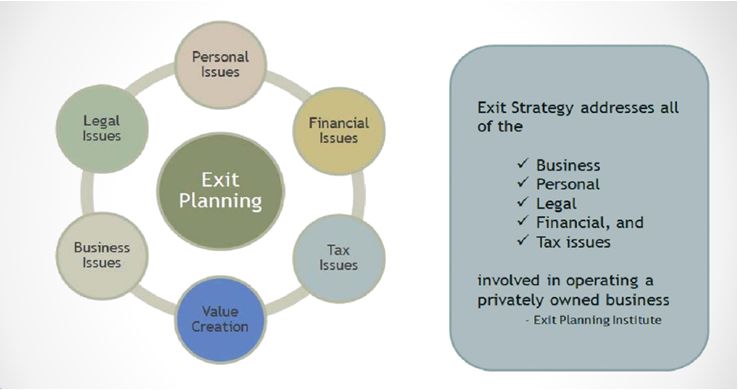Business exit planning is a form of strategic planning. Just as you would plan business growth and the structure of your business that supports that growth, exit planning provides a look at the end game so that you have a clear direction as to where you are headed and by when.
Running a business means dealing with and planning for the prevention of many different issues on a regular basis. Exit planning deals with these same issues, but takes a longer view point. The objectives of the exit plan are to address these issues:
- Business Issues
- Financial Issues
- Personal Issues
- Tax Issues
- Legal Issues
- Value creation
Exit Planning: A Three Step Process
Most business owners don’t consider all these. Recently, I was speaking to the owner of a gas station and auto service center. When I mentioned exit planning he said, “Oh that’s no problem for me. I could sell this business in a minute.” What he doesn’t understand is that the sale of the business in only one part of exit planning. Exit planning is a process, not an event. It’s a three step process:
- Exit Readiness
- Value Creation
- And then Business Transition
Exit Readiness
When it comes to exit readiness many people will say they are ready because they have life insurance, a trust and/or will, and maybe even a buy/sell agreement among the partners. Of course, if a business owner doesn’t have these things in place, it’s the first thing we do in order to protect against unexpected events such as death, disability, or health challenges. This is important, but it’s not enough.
There is more to do than simply taking care of contingency planning with your estate attorney, tax planner, or financial advisor.
Exit readiness must address your personal, financial, and business goals. Have you considered?
- What will your life be like after you transition away from the business?
- Will you have enough to live the lifestyle you want?
- Is there a plan to retain key management/employees after transition?
- Do your children want the business? If so, what needs to be done to get them ready?
- Will you stay on after the transition?
- If you have partners, are they ready to exit the business? If not, how does that affect your ability to exit when you want to?
- And lastly, is the business ready to be sold or transitioned? Is it at its maximum value?
Value Creation
Business value creation is a critical part of the exit strategy. Most business owners have the vast majority of their personal wealth in the business and they are depending on the proceeds or income stream generated from the transition to provide them with the lifestyle they are expecting in retirement.
So the earlier you start this step of the process the better. The more time you have to build the business the more it will be worth when you are ready to exit. So a big part of the exit planning process is to determine how to improve the value of your business and then implement those changes.
Business Transition
After you have created the value in the business that you want it’s time to explore exit options and select the best alternative. These options may include selling or merging the business, passing it on to your heirs, or liquidating the business.
As you can see, transitioning away from your business is the last step in the exit planning process, not the first. If you are not ready from a personal, financial, and business perspective the transition from your business may not be as easy as you expected.
Contact me to take your personal Exit Planning Assessment (FREE) to determine how prepared you are to exit your business.

